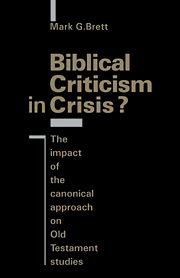Book contents
- Frontmatter
- Contents
- Acknowledgements
- List of abbreviations
- Introduction: Setting the scene
- 1 Distinguishing interpretative interests
- 2 The development of canonical exegesis
- 3 ‘Introduction’ and Old Testament theology
- 4 Has Childs fallen into Gabler's ditch?
- 5 Textual intentions and histories of reception
- 6 The future of the canonical approach
- Notes
- Bibliography
- Bibliographical key to the works of Brevard S. Childs
- Index of Old Testament references
- Index of subjects
- Index of authors
2 - The development of canonical exegesis
Published online by Cambridge University Press: 10 October 2009
- Frontmatter
- Contents
- Acknowledgements
- List of abbreviations
- Introduction: Setting the scene
- 1 Distinguishing interpretative interests
- 2 The development of canonical exegesis
- 3 ‘Introduction’ and Old Testament theology
- 4 Has Childs fallen into Gabler's ditch?
- 5 Textual intentions and histories of reception
- 6 The future of the canonical approach
- Notes
- Bibliography
- Bibliographical key to the works of Brevard S. Childs
- Index of Old Testament references
- Index of subjects
- Index of authors
Summary
THEORY AND PRACTICE
I have so far characterized the canonical approach in the following terms: it may be understood as a new type of interpretative interest (most closely related to, but distinguishable from, emic description) which, for theological reasons, seeks to interpret biblical texts in their final form. In reaching this formulation I have drawn from the work of Childs in a highly selective way, and this ad hoc method of reconstruction finds its justification in the fact that Childs himself has failed to provide a coherent exegetical theory. That is to say, he has not yet provided a sufficiently clear and explicit discussion of the interpretative interests and concepts that shape the canonical approach. This lack of coherent theory has turned out to be one of the major obstacles to a balanced appreciation of his work. Nevertheless, a reconstruction of the canonical approach cannot be undertaken simply on the theoretical level; it also requires a patient account of Childs's actual exegetical practice. To rephrase a famous philosophical attack on metaphysics: practice without theory is blind, theory without practice is empty.
Discussions of Childs have tended to focus on his publications since Biblical Theology in Crisis (1970). It would certainly be a mistake to assume that, given a sufficiently sensitive reader, an author's work (in this case extending over thirty years) can always be knitted together into a seamless whole. Nevertheless, I would suggest that there are certain elements in Childs's work which have been present ever since his early studies on myth, published in 1960.
- Type
- Chapter
- Information
- Biblical Criticism in Crisis?The Impact of the Canonical Approach on Old Testament Studies, pp. 27 - 57Publisher: Cambridge University PressPrint publication year: 1991



